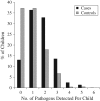Comprehensive Analysis of Prevalence, Epidemiologic Characteristics, and Clinical Characteristics of Monoinfection and Coinfection in Diarrheal Diseases in Children in Tanzania
- PMID: 28541454
- PMCID: PMC5860328
- DOI: 10.1093/aje/kwx173
Comprehensive Analysis of Prevalence, Epidemiologic Characteristics, and Clinical Characteristics of Monoinfection and Coinfection in Diarrheal Diseases in Children in Tanzania
Abstract
The role of interactions between intestinal pathogens in diarrheal disease is uncertain. From August 2010 to July 2011, we collected stool samples from 723 children admitted with diarrhea (cases) to 3 major hospitals in Dar es Salaam, Tanzania, and from 564 nondiarrheic children (controls). We analyzed the samples for 17 pathogens and assessed interactions between coinfections in additive and multiplicative models. At least one pathogen was detected in 86.9% of the cases and 62.8%, of the controls. Prevalence of coinfections was 58.1% in cases and 40.4% in controls. Rotavirus, norovirus genogroup II, Cryptosporidium, and Shigella species/enteroinvasive Escherichia coli were significantly associated with diarrhea both as monoinfections and as coinfections. In the multiplicative interaction model, we found 2 significant positive interactions: rotavirus + Giardia (odds ratio (OR) = 23.91, 95% confidence interval (CI): 1.21, 470.14) and norovirus GII + enteroaggregative E. coli (OR = 3.06, 95% CI: 1.17, 7.98). One significant negative interaction was found between norovirus GII + typical enteropathogenic E. coli (OR = 0.09, 95% CI: 0.01, 0.95). In multivariate analysis, risk factors for death were presence of blood in stool and severe dehydration. In conclusion, coinfections are frequent, and the pathogenicity of each organism appears to be enhanced by some coinfections and weakened by others. Severity of diarrhea was not affected by coinfections.
Keywords: biological interactions; coinfections; diarrheal disease; monoinfections; pathogenicity.
© The Author(s) 2017. Published by Oxford University Press on behalf of the Johns Hopkins Bloomberg School of Public Health.
Figures

Similar articles
-
Aetiology of diarrhoeal disease and evaluation of viral-bacterial coinfection in children under 5 years old in China: a matched case-control study.Clin Microbiol Infect. 2016 Apr;22(4):381.e9-381.e16. doi: 10.1016/j.cmi.2015.12.018. Epub 2015 Dec 25. Clin Microbiol Infect. 2016. PMID: 26724990 Free PMC article.
-
Coinfection with Enteric Pathogens in East African Children with Acute Gastroenteritis-Associations and Interpretations.Am J Trop Med Hyg. 2018 Jun;98(6):1566-1570. doi: 10.4269/ajtmh.17-0473. Epub 2018 Apr 19. Am J Trop Med Hyg. 2018. PMID: 29692296 Free PMC article.
-
Synergistic effects between rotavirus and coinfecting pathogens on diarrheal disease: evidence from a community-based study in northwestern Ecuador.Am J Epidemiol. 2012 Sep 1;176(5):387-95. doi: 10.1093/aje/kws220. Epub 2012 Jul 25. Am J Epidemiol. 2012. PMID: 22842722 Free PMC article.
-
Diarrheal Etiology and Impact of Coinfections on Rotavirus Vaccine Efficacy Estimates in a Clinical Trial of a Monovalent Human-Bovine (116E) Oral Rotavirus Vaccine, Rotavac, India.Clin Infect Dis. 2019 Jul 2;69(2):243-250. doi: 10.1093/cid/ciy896. Clin Infect Dis. 2019. PMID: 30335135 Free PMC article. Clinical Trial.
-
Occurrence and investigation of enteric viral infections in pigs with diarrhea in China.Arch Virol. 2013 Aug;158(8):1631-6. doi: 10.1007/s00705-013-1659-x. Epub 2013 Mar 15. Arch Virol. 2013. PMID: 23494226 Review.
Cited by
-
Viral Pathogen-Specific Clinical and Demographic Characteristics of Children with Moderate-to-Severe Diarrhea in Rural Bangladesh.Am J Trop Med Hyg. 2019 Aug;101(2):304-309. doi: 10.4269/ajtmh.19-0152. Am J Trop Med Hyg. 2019. PMID: 31264563 Free PMC article.
-
Collider Bias Assessment in Colombian Indigenous Wiwa and Kogui Populations with Chronic Gastroenteric Disorder of Likely Infectious Etiology Suggests Complex Microbial Interactions Rather Than Clear Assignments of Etiological Relevance.Microorganisms. 2024 May 11;12(5):970. doi: 10.3390/microorganisms12050970. Microorganisms. 2024. PMID: 38792799 Free PMC article.
-
Performance and operational feasibility of two diagnostic tests for cryptosporidiosis in children (CRYPTO-POC): a clinical, prospective, diagnostic accuracy study.Lancet Infect Dis. 2021 May;21(5):722-730. doi: 10.1016/S1473-3099(20)30556-9. Epub 2020 Dec 3. Lancet Infect Dis. 2021. PMID: 33278916 Free PMC article.
-
Enteroinvasive Escherichia coli O96:H19 is an Emergent Biofilm-Forming Pathogen.J Bacteriol. 2022 Apr 19;204(4):e0056221. doi: 10.1128/jb.00562-21. Epub 2022 Mar 28. J Bacteriol. 2022. PMID: 35343774 Free PMC article.
-
Etiological Spectrum of Infective Diarrhea in Renal Transplant Patient by Stool PCR: An Indian Perspective.Indian J Nephrol. 2021 May-Jun;31(3):245-253. doi: 10.4103/ijn.IJN_169_20. Epub 2021 Feb 16. Indian J Nephrol. 2021. PMID: 34376938 Free PMC article.
References
-
- Liu L, Oza S, Hogan D, et al. . Global, regional, and national causes of child mortality in 2000–13, with projections to inform post-2015 priorities: an updated systematic analysis. Lancet. 2015;385(9966):430–440. - PubMed
-
- Black RE, Cousens S, Johnson HL, et al. . Global, regional, and national causes of child mortality in 2008: a systematic analysis. Lancet. 2010;375(9730):1969–1987. - PubMed
-
- Kotloff KL, Nataro JP, Blackwelder WC, et al. . Burden and aetiology of diarrhoeal disease in infants and young children in developing countries (the Global Enteric Multicenter Study, GEMS): a prospective, case-control study. Lancet. 2013;382(9888):209–222. - PubMed
MeSH terms
LinkOut - more resources
Full Text Sources
Other Literature Sources
Medical

